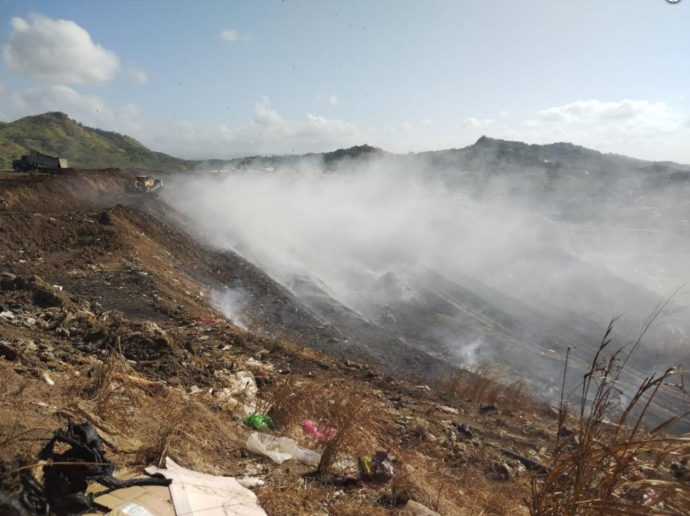The metro area’s Cerro Patacon dump smolders. Bombero Corps photo.
They said there was an agreement.
Then they got down to the details.
by Eric Jackson
It’s a problem in municipalities large and small across this country, and it has been not so cleverly concealed for many years. Take the breakdown in contract talks between the government and the Ecolimpia consortium as but another chapter in a book of how things should not be run.
At the end of March the government announced the results of online contract bidding between two companies that wanted to take over management from the Colombian-based Urbalia. The latter complained about payments due and not made, while the Panamanian government complained of jobs not done, or not properly done. People within a radius of more or less two miles were frequently subjected to rotten garbage odors and smoke coming off of the 325-acre dump. Leaching toxic waters from the dump had contaminated the groundwater of some 22,500 acres.
So the contract with Urbalia was allowed to expire, and online bidding for a replacement contractor was held. Ecolimpia, a Panamanian consortium, went against a Colombian firm. The per-ton bid by Ecolimpia was actually a few cents higher, but that didn’t stop them from winning the bidding.
An online process for a public process vital to public health? Then surely the public should have been able to go online and peruse the experience and qualifications of the bidders — right? Not so. There seem to be no data available from Ecolimpia and it components of waste management jobs that they have done.
Just one more thing about Panamanian waste management that’s concealed from public view.
This country’s public health care agencies don’t DO epidmiological studies among people who live near city dumps, nor among people in communities that don’t pick up the solid waste and so the residents burn theirs in improvised pits? Alcaldes and representantes — or on a national government level, the Urban and Household Sanitation Authority (AAUD) — don’t want the infamy of causing tax hikes or raising garbage collection fees, especially during hard times when many people can’t afford to pay? Then don’t let the national government conduct or publish studies about how destructive the status quo really is. The comparison of cost cutting with children who die of leukemia just isn’t politically correct.
The arts and sciences of waste management are ancient and modern, improving all the time and with promising developments which sometimes do and sometimes don’t work out. And with associated costs, and charlatans in public and private posts ready to take advantage if they can.
Consider what Golgotha was. It was a city dump, near one of Jerusalem’s gates. Both human remains and animal offal got discarded there and were scavenged by dogs and birds looking to pick the meatier bones. Some folks found things to recycle. A lot of discarded things were burned. It was this eternally burning place, the model for the Christian Hell. As a political statement by the Romans, by the local government of the time and previously, a hilltop there was considered an apt place to execute criminals — and political or religious dissidents — thus branding them as disposable human trash.
It’s neither religiously nor politically correct to compare Panama’s refuse dumps to the reality of what Golgotha was. But there it is. It’s cheaper if you don’t take all related costs into account to run a dump on the ancient Golgotha model.
Fast forward to a time of plastics and myriad household and industrial chemicals. And to a place with a much larger population than the Jerusalem of more than 2,000 years ago had. And a different climate, with much wetter and longer rainy seasons. Add in some different soil conditions, too.
Modern solid waste management is a known set of arts and sciences. It’s about fire prevention to protect the air that people have to breathe. It’s about preventing the spread of disease-causing pathogens from the refuse to human or animal populations. It’s about preventing, channeling and cleaning the toxic liquids that will run off of dump sites, or seep down into the groundwater from which people and animals drink. It’s a lot of work and significant expense to do properly. It can’t be well run if it’s subject to a massive change of personnel every five years, with minimally qualified political hirees going and coming.
Cerro Patacon is a problem that has been growing for years. At the start of Martinelli times the dump, although in San Miguelito, was a Panama City property. There were clearly problems and what to do, and who gets to collect, became a cadaver of contention between the slick and dishonest president and the stupid and dishonest mayor.
A big incinerator to magically turn trash into energy? Sounds reasonable to someone who hasn’t done any homework on the world’s ample experience that those sorts of things. But hey, Panamanian public education is intentionally held back from what it should be, and this country has criminal defamation laws to oppress those pesky journalists who might refer to the international problem between the US state of Michigan and the Canadian province of Ontario when the Detroit metro area was burning its refuse upwind from the greater Windsor area. Paper, plastic and food scraps are problem enough, but throw in batteries, aluminum and the residues of household and industrial solvents and it becomes a recipe for huge public health issues. You wouldn’t expect Bosco the Clown to know such a thing, nor to care. You might expect someone else to know perfectly well, go ahead and create the problem and designate a scapegoat onto whom blame could be shifted.
As it turned out Cerro Patacon was nationalized, and generally through private contractors run much as it had been. Urbalia was the latest of these, hired by the AAUD to manage the dump.
So, why didn’t Ecolimpia move right in? Because they insisted on being definitively given the job at once, without hammering out the details of the contract. Because when talking about the details, Ecolimpia balked at including security to, for example, keep people from coming onto the site and setting fires. Because Ecolimpia wanted control and remediation of the toxic runoff and seepage to be somebody else’s job. They also wanted the capture of methane gas from buried rotting garbage and the maintenance of roads within the dump to be somebody else’s costs. Ecolimpia, the AAUD complained, wanted something like the standard pay without delivering the standard services. So, some three weeks after the AAUD announced Ecolimpia as the winning bidder, the deal was called off by the government and the AAUD will start a new bidding process for Cerro Patacon management.
The Environmental Litigation Center (CIAM), a nonprofit public interest law firm, takes a grim view of it all:
Uncontrolled stormwater management, non-existent leachate treatment, lack of waste cover, free dispersal of biogas, lack of operator safety and poor landfill operation have been known for more than 20 years.
Many long-time observers have opined that Cerro Patacon is filled more or less to capacity and needs to be replaced, even if continued monitoring and management will be needed for a long time to come.
But to former Panama City deputy mayor, architect and environmental activist Raisa Banfield, the city dump doesn’t have to be a problem. She says that there are companies that have done good waste management jobs elsewhere, but that when none of them applied to bid on the Cerro Patacon job it said a great deal about the nature of the process.
Which opinion set off the predictable partisan troll farms. That she had served in government and was not politically aligned with the people running this process were as might be expected taken as proofs of her malicious partisan intentions. Even though she is and long has been an independent, and has not announced any plans to run for office in 2024.
Contact us by email at fund4thepanamanews@gmail.com
To fend off hackers, organized trolls and other online vandalism, our website comments feature is switched off. Instead, come to our Facebook page to join in the discussion.
These links are interactive — click on the boxes












